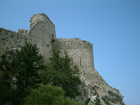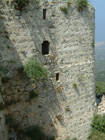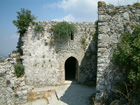North Cyprus Yeni Iskele
Kantara Castle
Described as the most romantic of all the Byzantine or Crusader trio castles, Kantara Castle is the easternmost and lowest one poised at the spot where the Kyrenia range subsides into rolling hills.
How to get there
It is situated 26 miles north of Famagusta . If you travel from Kyrenia, Kantara is the most distant castle to reach and for this trip whole day should be given. It is approximately 45 miles (72.4 km) from Kyrenia. Picturesque route to the destination has however, its distinct features. If you follow the main Famagusta road out of Kyrenia take the turning left which is signposted "Esentepe", "Taltlisu", "Acapulco" and "Alagadi Green Turtles Beach". Spanning the coastline, you can enjoy the agricultural landscape covered in vegetables and fruit. If you start from Bogaz it is at least 45-minute drive. From Kaplica on the coast, the ascent route to Kantara is narrow but quite driveable and there are regular passing places along the way. There is no direct public transport that reaches the castle.



Practical info
A useful map and potted history is outlined on your ticket and it should take you an hour or so to make a relaxed tour and enjoy the views. If visiting the castle with children, you should keep them from serious unfenced drops, rough scrambling and uncapped holes. Do not forget to take camera, binoculars, walking stick, a bottle of water with you and remember to wear proper shoes.
Opening hours: Summer 10.00 - 17.00, winter 9.00- 14.45
Admission: appr. YTL 4.00
Castle name
The name of the castle is said to be derived from the Arabic quantara, which means "arch" or "bridge", although it is hard to pinpoint such a structure in the surrounding landscape.
Castle history
Presumably Kantara is reckoned to be the place where Isaac Komnenos surrendered to Richard the Lionheart in 1191, like Buffavento and St Hilarion. During 1228-30 it was occupied by the troops of the Holy Roman Emperor Frederick II who was struggling for his take-over of the island. Kantara Castle figured prominently in the war during the Genoese invasion, when the regent John of Antioch was smuggled out of prison in Famagusta disguised as a pot-tinner. James I added the fortifications to the caste and from this vantage point his garrison was able to keep watch over Famagusta and the surrounding area. After the Venetian invasion in 16 th the castle was partially dismantled and its significance faded. Set on a rocky summit at the eastern end of the mountain range, Kantara is just 700m, the lowest of the castle trio. However, it has commanding view up the Karpaz peninsula, all along the northern coastline and down to the plain to Famagusta . From this position it was used as a beacon station to communicate with Buffavento and St Hilarion to the west.
Castle tour
You enter the outer enceinte through a barbican that is flanked by a pair of towers, the north tower and the south tower . Then you can go on climbing the steps to the inner ward. If you stop here, there is a massive southeast tower, with its lower part - a cistern which occasionally doubled as a dungeon . Further along the southeast wall are the barracks, a trio of rooms fitted with loopholes. Next to this are the latrines that were once flushed by the castle's sophisticated plumbing system, and also garrison and a water cistern . Up to here the buildings are in good conditions, down to the woodwork and ceilings, the castle is pretty much in ruins until the southwest corner of the battlements, where one chamber contains a hidden postern gate used to catch would-be attackers by surprise. Passing the inner bailey, or returning to the southeast tower, you can reach the northern tower. Both the towers feature a significant peace of military design with two long galleries equipped with arrow slits and joined by a square chamber. Of the highest watchtower, that would be lit to alert the residents of any danger, just one wall and a Gothic window still exists. By contrast, the northern bastion is impressively complete.








